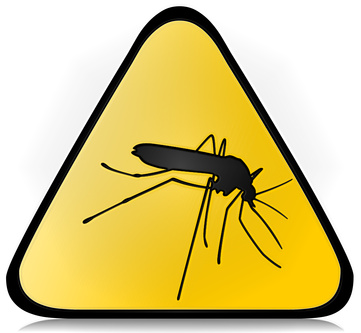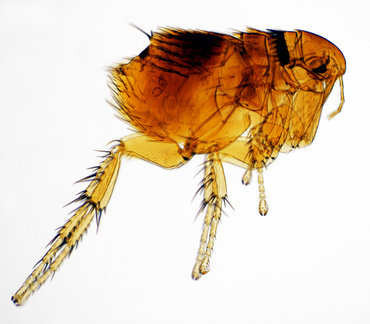
A worm going, 3 worms…
| Short quiz on worms affecting your pets . 1- Some worms can become lodged in the heart of the dogs and cats. True/false True ! Some worms transmitted by mosquitoes can penetrate through the skin, and then migrate to the heart of our pets and colonize the pulmonary artery.
This condition is called heartworm : It is a serious illness that can develop over several months and is often fatal. It affects dogs and cats. Heartworm disease is present in the South of the France and particularly in the Mediterranean and Corsica… If you go on vacation in these regions , Remember to ask your vet an effective treatment against this type of parasites but also means of prevention against mosquitoes (There are collars or pest control pipettes allowing away them). The mosquito is not the only vector of heart worms : snails and slugs can also transmit to the dogs a worm named Angiostrongylus. Dogs will infest by swallowing the mollusc. Contained in the snail or slug worms are then released into the stomach of the animal, and then migrate to the heart. There still, death can occur at any time. The disease is more strongly present in humid regions, swamp where you meet lots of snails and slugs. Fox plays the role of tank and its presence in some areas increases the risk of angiostrongylose. The only way to control this disease is to perform a regular deworming of your pets with treatments that your veterinarian will advise you. The fight against snails and slugs is an illusion…
2- Fleas can transmit worms in dogs and cats: True/false
True ! Fleas transmit to our pet of worms called Dipylidium caninum which cause digestive disorders (vomiting, diarrhea) and anal itching. Dogs and cats contaminated by swallowing a scratchy chip ( for example, in licking), then the larva of Dipylidium is released in the gut and then transforms into adult worm. The interest to treat your pet against fleas is twofold ! It allows, not only to get rid of fleas but also to avoid contamination with the Dipylidium !
3- My cat may have tapeworm. True/false True ! As the man, the cat can host a tapeworm which reached easily 1 meter long ! It is precisely the Dipylidium caninum transmitted by fleas. It is characterized by the elimination of ring in the parasitic animal feces. Another type of tapeworm, Taenia can be forwarded to our animals by rodents (Attention hunters cats !).
4- The man can be contaminated by dog and cat worms : True/false True ! Very many verses present in dogs and cats are transmissible to humans, including through feces, and can lead to various pathologies. The most serious are echinococcosis causing humans problems liver and can be fatal. Human infection occurs by ingestion of eggs of Echinococcus which are present in the feces of dogs, cats, Wolves, or parasitic foxes. Think that these eggs may be present in the coat of your pet, in her mouth (After to be groomed), on the vegetables or berries (Blackberries, myrtillles) collected in the field. Hygiene rules are essential to avoid contamination (regularly wash hands, Rinse fruits and vegetables before consumption, avoid letting lick by her pet…).
Toxocariasis is an another communicable disease through cats and dogs. It is a serious parasitic disease that causes, especially in children, ophthalmological disorders that may result in the loss of sight. Contamination is, There still, ingestion of these eggs in the feces of dogs and cats contaminated. Attention to the sandboxes for children where cats are happy to their needs ! Observe strict rules of hygiene and protect you in vermifugeant your pets regularly !Your veterinarian can advise you about effective products and their frequency of administration.
5- I see no worms in the stool of my dog, so he did not. True/false Fake ! This is not because it is not worms in the feces of her pet, what it is not ! Although often, only the eggs are present in the feces and they are visible only under a microscope !
6- That is what it is?
Photo: www.RUF-der-Wildnis.de A: a mollusc B: a worm of the dog and the cat, mortal for humans C: a sea anemone
Answer B: Here, seen with the electron microscope, the famous "Echinococcus multilocularis" that our pets and which can be fatal to humans. You can discern the suction cups that allow it to bind to the digestive wall !
7- A kitten that is born can not have worms. True/false
Fake ! A kitten may have been contaminated by its mother during pregnancy (some worms pass through the placenta). Newborns may also be contaminated by worms as soon as their first breastfeed through breast milk ! It is therefore advisable to deworm kittens early (at the age of 3 weeks), and then repeatedly : first all the 15 days, then every month up to the age of 6 months at least.
8- I can deworm my dog with a clove of garlic. True/false.
Fake ! Garlic is in no case an effective Wormer ! To choose your Wormer, consult your veterinarian ! Be aware that there are many forms : tablets, oral solutions, oral pasta or pipettes which content should be deposited on the skin of your pet. § The sources of contamination of our dogs and cats are many. The most common are the feces of stray animals, but mosquitoes, fleas, rodents, ingestion of contaminated meat or milk are possible sources ! Dogs and cats that host worms may experience symptoms such as digestive disorders, weight loss, but also the cough and heart disorders. They can also present no symptoms and be contagious to their congeners and even for human ! So think about deworm regularly your little friend ! For a dog or an adult cat, a rate of 2 to 4 twice a year is recommended according to assessed risks by your veterinarian. |





